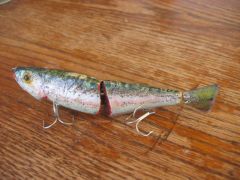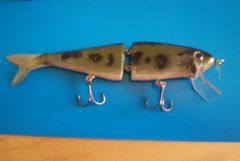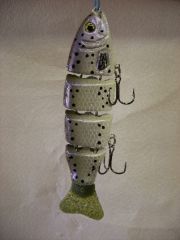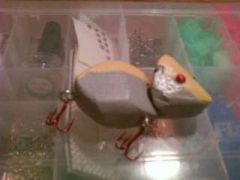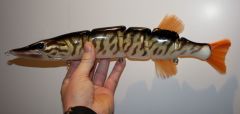-
Posts
14,726 -
Joined
-
Last visited
-
Days Won
364
Content Type
Profiles
Articles
TU Classifieds
Glossary
Website Links
Forums
Gallery
Store
Everything posted by mark poulson
-
I think it's cause by cavitation. When the water passes through the holes, it's slowed by the walls of the hole, and so it's under lower pressure than the surrounding water. This causes dissolved gases to precipitate out, forming bubbles. At least, I know that's the reason it's important to ream copper pipes when you're running water likes. The chlorine in the water, which is dissolved and harmless to the copper piping, will precipitate out when it passes over a rough spot, and the chlorine gas will eat the copper.
-
Pete, I did make a popper with holes from PVC, and it works fine. And no problems with sealing.
-
Mike, Really nice job. Those eyes look great. I think they'll add to the "hydralic profile" of the lure as it moves through the water. Delta Man, That's a great idea to use the round headed pins for eyes. I was wondering how to add eyes to a craw crank. I bet you could leave the pin sticking out a little, and get the "eye on a stalk" effect. Cool
-
Deltaman's right. White pine is a great wood to carve, especially if you're making a prototype. And you can fix mistakes with bondo. Sharp tools and light pressure are the key to good carving. Don't try to do it all at once. And put something on your leg for protection when you carve. I use my left thigh as a base for carving, so I drape a doubled towel over it. One slip can ruin your day.
-
From my experience, loose joints are the key to slow speed swimming action. If my lure can bend into a U shape when I hold it with the head facing down, it will swim at all speeds. When I showed one of my 7" swimbaits to Bill Siemantel recently, the first thing he did was the U shape test. When he saw it made the full U, he said I'd got it. I also keep the ballast toward the front as much as possible, so the tail is free swinging.
-
The DT 16 casts better than the DD 22 in part because it weighs 5/8 oz, instead of the 1/2 oz the Norman weighs. Before deep cranks became so popular, I used to tie a Fat Free Shad onto my C rig, and fish it as deep as I wanted. Typically, I fished it down to 40', and caught fish. The only drawback was the lure sometimes spiraled on the fall, and wound up fouled. I figured out pretty quickly it was probably not going to get bit when it was fouled, so I used to watch it like a hawk on the cast, and I found that it was much more consistent down to 30'. After that, the fouling really became an issue. I also used shallower cranks on the C rig, and they seemed to not foul at all. With appologies to those who think water pressure is that big a deal in terms of how a crank behaves, I think the lure's action is the same at all depths, or at least the depths I want to fish. I'm sure that there are differences at 100', but those deep fish probably wouldn't care anyway. If they saw a crank down that deep, they'd be so surprised they'd eat it out of shock!
-
fivefishwish, Glad I'm not the only one. Seems like the older it get, the stumpter I get.
-
-
PB, SC9000 is a waterborne urethane. I don't think it has active solvents that would do what you're describing. I really think the problem is trapped moisture in uncured coats of paint. I would dry every coat as it's applied, including the primer after it's flashed off, and see if this doesn't cure the problem. Otherwise, I'm stumped. I've only had an orange peel problem once, and that was on the second dip, because I didn't wait the full two hours, and hadn't yet figured out you can heat set the uretane between dips to accelerate the process.
-
-

What Power Fishing Rod For Your Jointed Swimbaits?
mark poulson replied to mainbutter's topic in Hard Baits
There are a ton of great rods out there. And all of them can do the job. Being able to cast a swimbait with accuracy, and with distance, are the hallmarks of a good swimbait rod. They are all powerful enough to handle big bass and strippers. But swimbaits don't require the degree of superior performance that other techniques, like drop shot or cranking, call for in a rod. I own a bunch of swimbait rods, from BPS flipping sticks to Shimano Crucials and Terras. If I had it to do over, I'd only buy the Okuma Guide Select swimbait rods. They are $109+- at Tacklewarehouse, and ship for free. They are light, have great actions, and have a lifetime warranty. I know, because I snapped off a tip when I caught it under a bracket. No hassle replacement direct from Okuma. One week turnaround, if I recall. I use a 7'6" med. heavy for smaller swimbaits, and for Punkers and bigger top waters. I use a 7'11" med heavy for 3-4 oz. swimbaits, and a 7'11" heavy for 5oz and up, like my 10" joint baits, or Hudleston deluxe 8". No need to spend more. I tried the Diawa Heartland rod, and found it was too limber for me for accurate casting. To me, it's more of a salmon bounce back rod, for deep trolling weighted baits. I returned it to Tacklewarehouse, and was given a refund, no questions asked. A really class outfit. I would offer this advice. Don't overcomplicate it. KISS "Keep it simple, stupid" And cheap, if it gets you the same result. -
Your choice of wood may be the problem. Sounds like it's not buoyant enough for a floater that's properly ballasted. Try some suspend dots or tape, or wrap some lead wire/solder around the front hook shank, to see if you can achieve stability without losing all buoyancy. As was stated, small lures magnify any problems. You may have to use a more buoyant material to start with, like balsa, in order to be able to add stabilizing ballast. Gene's Rapala cut away should give you a good start if you find you need to switch to balsa.
-
When I repaint a lure to a ghost pattern, I scrape/wet sand until the old paint is off, and all I have left it the transparent plastic, which is typically cloudy from scraping and sanding. I typically remove the eyes, since they're too hard to mask, and I have more to add after paint. Then I dip the lure in some clean acetone, holding it by the bill, which I've masked off with blue tape, and hang it by the line tie to dry. The acetone dissolves the outer layer (micro thin layer) of the original plastic, and gets rid of all the scraping and sanding marks. And it leaves a clean surface that the paint will bond to. Then I spray the back and shoulders with irridescent violet paint from Wildlife. Really light coats, heat set between coats, building until I can just barely see the violet when I roll the lure back and forth. I add some 3d eyes. The site sponsor on the right of this page sells really good ones, cheap. Then I coat it with SC9000 urethane, and it's ready to fish. I've fished lots of my baits finished like this and never had a paint failure. Bear in mind, when a plastic lure is in the water, the water fills the scratches and makes it appear smooth, anyway, the same way those "miracle" eyeglass restorers work. You can test this by wetting a sanded lure, and seeing how clear it becomes.
-
I've found that, with the four piece swimbaits I make, the joints have to be loose enough that the lure will form a complete U when held by the head, facing down. I typically use two screw eyes per joint, to prevent binding, and make sure the last/tail joint is looser than the others. I add ballast as needed, starting from the head and working back, but I never put any in the last section, even on fast sink lures. If I can manage it, I only add ballast to the first two sections. A buoyant tail section insures free action at all speeds, and keeps the bait oriented on the fall. When I used weighted hook hangers, there was already 3 grams of weight in the third section automatically, and those lures swam fine. Now, I only add weight to the third section if I absolutely have to. Be sure you sand and seal your lures well before testing, especially in the joints, which need to be totally free swinging. You don't want friction from rough joint surfaces clouding the action of the bait, and giving you a false feedback. I have also used Plano dividers for tails, and they work great, especially on smaller baits that are meant to swim at moderate to fast speeds.
-
I dip while the parts are still warm, with no problems. I heat set every coat of paint completely, first low and then high, not just at the end. Maybe you still have some residual water in the paint that's affecting the finish. No specific speed, although I don't let them soak. I guess I'd say I dip them quickly. I just put them in until they're totally covered, and pull them out. I hang them inside the jar and tip them to get as much excess as possible dripped back into the jar, and then hang them. If the finish pools in one of the joint recesses, I wick it off with a paper towel, and, as drips form on the bottom, I rub the drips on the newspaper I've spread below my drying rack for drips to remove them, and then rehang the part. I used to use a paper towel to remove the drips, and that works, too. I usually only have to remove drips twice before they stop forming, and then I hit the part with the hair dryer, first on low, and then on high.
-
-
I think Dave's probably right. I use SC9000 over Wildlife colors, and don't have that problem. But I do use the hair dryer, first on low and then on high, to heat set my paint well before I dip. The only orange peel I ever got was when I dipped in the SC9000 the second time before the first coat was really dry. I got a wrinkling effect that actually looked kind of cool. It looked kind of like your lures, but a little more pronounced. If the orange peel occurs between coats of urethane, you may not be waiting long enough between dips. Now I hit the lures with a hair dryer after each dip in the urethane, before I dip them again, just to be sure the first coat is really dry. By paying attention, and heating them periodically, I can even cut the time between dips to 1 hour. The hair dryer is your friend.
-
-
-
Some transparent colors, like Wildlife irridescent violet, actually flash off and on, depending on how the lure is held. It has something to do with the shape of the pigment particles, I think. They give you a chance to add subtle color changes, like hilighting the shoulders and back of a lure, but keeping the original paint scheme. Light coats are the key.
-
And a Happy New Year to you. That lure moves great. I have rat lures that don't swim that well! You are, indeed, a very creative person. Now the big question. Soda tops, or water bottle tops, which are clear/opaque?
-
-




